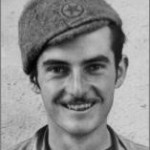Commissar Nicholas Myer — unattributed
The Volunteer for Liberty, V.2, No. 35, November 7, 1938.
Nick Myers, Commissar of Co. 1, Mac-Pap Battalion was wounded in the attack on Asco by the same shell that laid out Lionel Edwards the Company Commander.[i]
“I heard it coming” he says “but I was in a hurry and kept going. I ran a hundred yards before I knew I was hit. Then I saw blood running down my wrist and over my rifle.”
A piece of shrapnel had drilled his upper arm from elbow to shoulder.
Like many of the Canadians in Spain, Myers has been a goldminer, a logger, and a free-lance worker; in the depression years—jumping the freights from one job to the next. He’s ran a tractor hitched to a wheel combine, hefted rails and driven spikes for a couple of railroads and served an apprenticeship as a blacksmith.
“Blacksmithing is the best job” he avers. “It’s hard work boy! But I love it. If I ever get a chance I’ll go back to it.”
Of medium height and lightly, Nick doesn’t look much like a Village Blacksmith, but he has the unassuming ways that often go with the physical strength and his biceps are more than adequate.
He joined the working-class movement in 1933 in Alberta – his native province – when he was only 15 years old. A little later he landed in a Vancouver jail for three months as a result of a mass unemployment demonstration designed to force the Canadian government to give the workers relief.
“But we go the relief,” he exults. “An election was coming up in a few days and they couldn’t take it. They set up a government highway project in a hurry and slammed us on it.”
His high point in Spain was at Calaceite, where, acting as Section Leader after the former one was killed, and completely surrounded by enemy, he directed his men in resisting powerful attacks for more than two hours. Six fascist tanks and over 200 infantrymen assaulted the hilltop where Nick and his handful held out with few cartridges, no bombs and a defective light maxim.
Finally, realizing that the rest of our forces had withdrawn, he ordered his men to break up into small groups and make their way back to our lines. They all got back.
After that he was posted outside Mora de Ebro in charge of a 20-man detail of scouts to warn of the approach of the enemy to the Mora bridgehead.
The detail was armed with new type automatic rifles which only Nick handled before and supplied with a camion for rapid withdrawal. They stuck until the enemy appeared in force and then – their functions performed – dashed for the bridge which was blown up as soon as they passed.
As a Commissar, Nick attributes most [of] his success to “the help of good guys who were able to swing nearly everybody over to our way of thinking. I was green at the job and at first I figured a Commissar ought to be like a foreman in a lumber camp – a big hefty guy who could lick anybody in his outfit.”
[i] Fuentes de Ebro.















